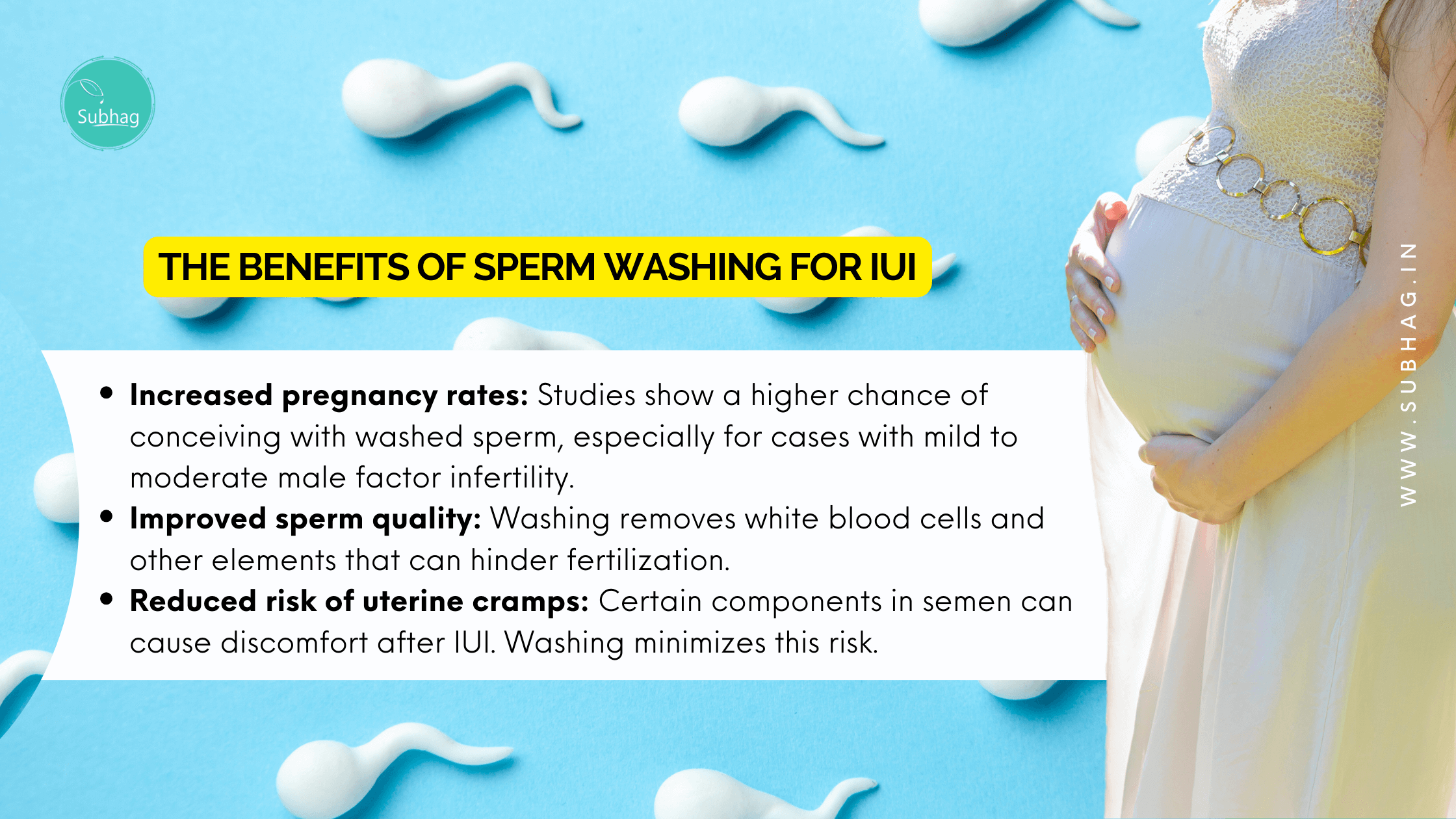Parenthood is a beautiful journey, but it can also be challenging, especially when it comes to fertility issues. For couples trying to conceive through IUI treatment, sperm washing can enhance their chances of success.
Sperm washing is a process that separates healthy sperm from semen, removes impurities and debris, and concentrates the sperm for better results.
In this blog, we will delve deep into the world of sperm washing for IUI treatment. From understanding what it is and how it works to exploring the different techniques used, we cover everything you need to know.
We will also share real-life success stories of couples who achieved parenthood with the help of this procedure.
So if you are considering IUI treatment or have any concerns regarding its success rate, read on as we guide you through the importance of sperm washing in enhancing your chances of achieving parenthood.
Understanding Sperm Washing
Sperm washing eliminates seminal plasma and white blood cells, separating motile spermatozoa. It reduces viral transmission risk in insemination. Vital for IUI and IVF, it aims to obtain healthy, motile sperm for infertility treatment.
The Purpose of Sperm Washing
Sperm washing removes debris, infectious agents, and reactive oxygen species from the semen sample.
It enhances sperm quality by reducing peroxidative damage and DNA fragmentation, improving pregnancy rates and reproductive outcomes.
It increases recovery of progressively motile sperm, vital for assisted reproductive technology, and is crucial for male factor infertility and unexplained infertility cases.
The Process of Sperm Washing
Sperm washing involves preparing the sperm using culture medium and separation techniques. The washed sperm is then used for artificial insemination, IUI, or IVF using the insemination technique.
Techniques include density gradient centrifugation, simple washing, and swim-up. Careful handling of the semen sample is crucial to minimize damage to sperm cells.
American Society for Reproductive Medicine standardizes sperm washing techniques.
Factors Influencing the Success of Sperm Wash
Semen quality, including semen parameters, plays a pivotal role in sperm wash for IUI treatment. Sperm count and motility directly impact the procedure’s outcome.
The density gradient technique significantly affects the recovery rate of motile spermatozoa.
The quality of the washed sperm, including semen parameters, influences sperm recovery rate and live birth rate. DNA damage and preparation techniques affect the chance of pregnancy.
Quality of Semen
The success of sperm wash for IUI treatment hinges on the quality of the semen sample.
High recovery rates are linked to normal spermatozoa parameters, while abnormal parameters can lead to low healthy, motile sperm yield. Reproductive outcomes of IUI are directly influenced by the semen sample quality.
Sperm Count and Mobility
The success of the sperm-washing procedure hinges on the sample’s sperm count and motility.
Higher counts and motility elevate the chances of obtaining a high yield of healthy, motile sperm, crucial for natural conception, IUI, and IVF procedures.
In the case of IUI, the density gradient technique aids in separating motile sperm based on density and motility, significantly impacting pregnancy and live birth rates.
Techniques of Sperm Wash for IUI Treatment
The sperm wash for IUI treatment uses techniques like density gradient centrifugation, swim-up, and density gradient to separate motile sperm based on their density and quality.
The appropriate technique is chosen based on the semen sample quality, which significantly impacts the success of the sperm wash procedure.
Standard Wash Technique
The standard wash technique involves the utilization of density gradient centrifugation or a simple washing method.
It is widely employed for sperm preparation in intrauterine insemination and IVF, ensuring the removal of debris, infectious agents, and white blood cells from the semen sample.
This technique yields a high recovery rate of healthy, motile sperm crucial for infertility treatment.
Swim-Up Technique
Utilizing the natural ability of motile sperm to swim upwards in a culture medium, the swim-up technique is a non-centrifugation method suitable for samples with high sperm motility.
It is particularly useful when the semen sample has a high count of motile spermatozoa and is preferred for cases where density gradient centrifugation may not be suitable.
Density Gradient Technique
The process of the density gradient technique involves the layering of semen samples over a density gradient medium and centrifugation to separate motile sperm based on their density and motility.
This technique effectively eliminates debris, white blood cells, and infectious agents from the sample, yielding a high recovery rate of healthy, motile sperm essential for assisted reproduction.
Risks and Safety Measures in Sperm Washing
Various potential health risks are associated with sperm washing, emphasizing the importance of strict safety measures. Adhering to these measures is crucial to prevent adverse effects during the procedure.
Safety measures are essential for minimizing risks and ensuring the effectiveness of the sperm-washing process.
Risks Associated with Sperm Washing
Sperm washing carries potential risks, including contamination and possible damage to sperm cells.
The risk of sample contamination is a key concern during the process, underlining the need for comprehensive safety protocols.
It may present risks such as the introduction of infectious agents into the semen sample. Awareness of these potential risks, especially when considering donor sperm, is crucial.
Measures to Ensure Safety During Sperm Wash
To safeguard the quality and integrity of the sperm sample, stringent safety measures are implemented during the sperm wash procedure.
The aim is to minimize the risk of contamination and maintain sample quality, ensuring successful reproductive outcomes. Robust safety measures protect the sperm sample from potential hazards, essential for mitigating risks during sperm washing.
Role of Sperm Wash in Enhancing IUI Success

Sperm washing plays a crucial role in preparing motile sperm for intrauterine insemination (IUI), enhancing the success rate of IUI procedures.
It significantly contributes to high-quality sperm preparation, optimizing the chances of successful outcomes. Understanding the role of sperm washing is vital for achieving favorable results in IUI treatment.
Importance of Sperm Wash in IUI
The necessity of sperm washing in IUI lies in optimizing sperm quality by removing seminal plasma and white blood cells.
High-quality, motile sperm prepared through this process significantly impacts the success of intrauterine insemination (IUI). It ensures the delivery of healthy sperm, enhancing the chances of successful IUI outcomes.
How Sperm Wash Increases the Chances of IUI Success
Sperm washing isolates high-quality, motile sperm for IUI, maximizing concentration and removing non-motile sperm.
This technique effectively increases the availability of healthy sperm, significantly improving fertilization and pregnancy chances. Sperm washing plays a crucial role in enhancing the success of IUI procedures.
Real-life Success Stories of IUI after Sperm Washing
Real-life success stories illustrate the positive impact of sperm washing on successful IUI outcomes.
Personal accounts highlight the procedure’s efficacy and positive outcomes, offering valuable insights into the benefits of sperm washing in IUI treatment.
These testimonials provide compelling evidence of the procedure’s tangible benefits and its role in enhancing IUI success.
Can Sperm Wash Make a Difference in Your IUI Treatment Journey?
Understanding the potential impact of sperm washing on your IUI treatment journey is crucial. It has the potential to significantly improve the success rate and guide your treatment decisions.
Assessing the transformative effects of sperm washing can help you make informed choices for a successful IUI experience.
Factors that may affect the success rate of IUI with sperm washing, such as age and fertility issues
Factors such as age, underlying fertility issues, and male infertility can significantly influence the success rate of IUI with sperm washing, impacting treatment efficacy.
Understanding these factors is crucial for managing patient expectations and providing valuable insights. Recognition of age, fertility challenges, and male infertility is essential when assessing the potential success of IUI with sperm washing.
Understanding the Importance of Sperm Washing in IUI Treatment
Comprehending the role of sperm washing in IUI is crucial for informed decision-making.
Understanding its significance offers valuable insights and prepares individuals embarking on IUI treatment.
Gaining insight into its importance proves pivotal in the preparation process, guiding patients through this reproductive biomedicine procedure.
Risks and limitations of sperm washing in IUI treatment
Sperm washing may not eliminate all infectious agents, posing risks.
Techniques might inadvertently damage sperm cells.
High yield of motile spermatozoa doesn’t guarantee pregnancy. It may not eliminate reactive oxygen species from sperm cells, risking peroxidative damage during the process.
Factors to consider when choosing a sperm washing method for IUI.
When choosing a sperm washing method for IUI, the recovery rate, risk of DNA fragmentation, and quality of washed sperm should be evaluated.
Additionally, the potential live birth recovery rate and the chance of pregnancy with the washed sperm sample are crucial factors to consider.
Potential benefits and success rates of using sperm wash in IUI
Enhancing the likelihood of conception compared to natural means, sperm wash improves sample motility and count, potentially reducing infectious agents and enhancing success rates.
Clinical data supports improved reproductive outcomes with sperm wash compared to simple sample washing. These benefits underscore the significance of sperm wash in enhancing IUI success.
Steps to Prepare for a Successful Sperm Wash Procedure
Avoiding ejaculation, intercourse, or lubricants before sperm collection is crucial.
Providing a contaminant-free sample container and informing the healthcare provider about medications or health conditions are essential steps. Following the provider’s instructions for sterile sample collection ensures the success of the sperm wash process.
How to Collect a Sperm Sample
Collecting the semen sample involves masturbation into a sterile container, ensuring the entire sample is collected for accurate analysis.
It should be kept at body temperature during transportation, avoiding contact with non-sterile objects. Seal the container tightly and label it with the correct identification information.
What Happens During a Sperm Wash Procedure
During a sperm wash procedure, the semen sample is mixed with a culture medium for lab processing. Density gradient centrifugation separates motile spermatozoa, while white blood cells and seminal plasma are removed.
The washed sperm sample is then utilized for intrauterine insemination (IUI), ensuring the use of the appropriate sperm-washing medium.
Common Techniques Used for Sperm Washing in IUI Treatment
Density gradient centrifugation separates motile spermatozoa, while simple washing technique separates motile sperm cells. Techniques like swim-up, density gradient, and wash media are used for sperm preparation, employing different centrifugation and separation techniques to obtain healthy sperm.
Specific techniques such as density gradient centrifugation, swim-up, or wash media are also used.
Steps Involved in Sperm Washing
Upon collection of the semen sample in a labeled, sterile container, it is diluted with a culture medium for analysis. Subsequently, centrifugation separates sperm cells from the seminal plasma.
The washed sperm sample is then resuspended in an appropriate culture medium for quality, motility, and concentration assessment.
Different Types of Sperm Washing Techniques
Sperm washing techniques include density gradient centrifugation, swim-up, and simple washing.
The density gradient separates sperm cells based on density, swim-up allows motile spermatozoa to swim into a fresh medium, and simple washing involves washing the sperm sample with a medium.
Other techniques like percoll gradient and migration-sedimentation also play a crucial role in semen preparation.
Tips for Improving the Success Rate of IUI with Sperm Wash
When enhancing IUI success, use high-quality sperm washing media and culture medium. Minimize sperm damage risk during washing and preparation.
Opt for techniques yielding healthy, motile spermatozoa. Use techniques ensuring high recovery rates of motile sperm. Consider additional studies on reproductive outcomes and clinical data.
Ensuring proper timing and frequency of insemination
Optimizing the chance of conception relies on the critical timing and frequency of insemination during IUI treatment.
The recommended frequency aligns with the ovulation cycle for effectiveness, emphasizing consistency for treatment success. Proper timing is essential, highlighting the significance of consistent timing and frequency for a successful outcome.
Maintaining a healthy lifestyle and diet during the treatment process
Lifestyle and dietary habits play a crucial role in supporting the IUI treatment process. Ensuring a healthy lifestyle and balanced diet can positively impact the treatment, contributing to its success.
Diet and lifestyle choices influence the overall outcome, enhancing the effectiveness of the treatment. Proper nutrition is essential for supporting reproductive biomedicine.
Communicating openly with your doctor and addressing any concerns or issues.
During the sperm wash process, communication with your doctor is crucial for successful IUI treatment.
By openly discussing concerns and following medical guidance, including the role of cervical mucus, the chances of a positive outcome improve.
Keep your doctor informed about any health changes or lifestyle adjustments that may impact the treatment. Seeking support from a fertility specialist or counselor is also advisable.
Frequently Asked Questions
What is sperm wash and how does it improve the success rate of IUI treatment?
Sperm wash is a process that separates healthy sperm from the seminal fluid and dead sperm.
It improves the success rate of IUI treatment by increasing the concentration of healthy sperm in the insemination sample.
This process involves washing the semen sample with a special solution and then spinning it in a centrifuge. Sperm wash also helps remove bacteria and viruses, reducing the risk of infection during IUI treatment.
How does the process of sperm wash work?
The process of sperm wash involves separating healthy, motile sperm from seminal fluid and contaminants.
A special media is added to the semen sample to separate the washed sperm, which is then concentrated for use in intrauterine insemination (IUI) treatment and in vitro fertilization (IVF).
This improves the quality of sperm for IUI, increasing the chances of successful fertilization.
Can using sperm wash be beneficial for couples who have been unsuccessful with traditional IUI treatments?
Using sperm wash, also known as intracytoplasmic sperm injection (ICSI), can be highly beneficial for couples who have faced unsuccessful traditional IUI treatments.
It eliminates dead and abnormal sperm, enhancing the chances of successful fertilization.
Additionally, it separates motile sperm from immotile sperm, improving the overall quality of the sample used in IUI.
Speak with a fertility specialist to explore if sperm wash or intracytoplasmic sperm injection (ICSI) is suitable for you and your partner.
How long does the process of sperm wash typically take?
The typical duration of the sperm wash process ranges from 1 to 2 hours. During this procedure, the sperm is separated from the seminal fluid using a specialized technique.
The washed sperm is then utilized for intrauterine insemination (IUI) treatment. For more details, consult your healthcare provider.
Is sperm wash a necessary step in all cases of IUI treatment?
Sperm wash is not always required for IUI.
It’s recommended when the male partner has low sperm count or poor motility. Removing dead cells and debris from the semen before IUI can enhance success.
Your doctor will determine if it’s necessary based on your situation.
Conclusion
Sperm wash plays a crucial role in enhancing the success of IUI treatment.
Removing impurities and increasing the concentration of healthy sperm, significantly improves the chances of fertilization. Factors like semen quality, sperm count, and mobility also influence the success of sperm wash.
Techniques such as the standard wash, swim-up, and density gradient are commonly used for sperm washing.
While sperm washing is generally safe, it’s essential to be aware of associated risks and follow safety measures during the procedure.
Understanding the importance of sperm washing in IUI treatment helps patients make informed decisions. Real-life success stories highlight the positive impact of sperm wash on IUI outcomes.
To prepare for a successful sperm wash procedure, follow proper sample collection guidelines and know what to expect during the process.
Additionally, improving the success rate of IUI with sperm wash involves timing insemination accurately, maintaining a healthy lifestyle, and communicating openly with your doctor.
For further guidance and expert advice, book a free consultation with our fertility specialists to explore the benefits of sperm wash in your IUI treatment journey.




